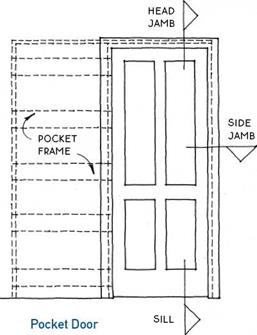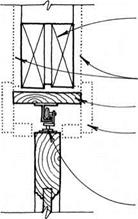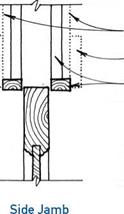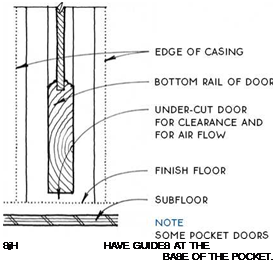INTERIOR HINGED DOORS
|
|
|
|
|
|
|





 Pocket doors – Pocket doors slide on a track attached to the head jamb and are sold as a kit, with the door and pocket separate and the pocket broken-down for ease of transport. The pocket is assembled at the site, and the head jamb (which much be set higher than 6 ft. 8 in. to allow for the track) is leveled, shimmed, and attached to the frame of the building. Next the pocket itself and the opposite jamb are shimmed and nailed. The heavier and wider the door and the better the quality of the hardware, the less likely the door is to derail. Pocket doors can’t be made to seal as tightly as hinged doors. The walls are flimsy at the pocket, and wiring or plumbing can’t be put in this section of wall.
Pocket doors – Pocket doors slide on a track attached to the head jamb and are sold as a kit, with the door and pocket separate and the pocket broken-down for ease of transport. The pocket is assembled at the site, and the head jamb (which much be set higher than 6 ft. 8 in. to allow for the track) is leveled, shimmed, and attached to the frame of the building. Next the pocket itself and the opposite jamb are shimmed and nailed. The heavier and wider the door and the better the quality of the hardware, the less likely the door is to derail. Pocket doors can’t be made to seal as tightly as hinged doors. The walls are flimsy at the pocket, and wiring or plumbing can’t be put in this section of wall.
Bypass doors—Bypass doors, such as sliding closet doors, slide on a track, like pocket doors, but have a double track and two doors that are not concealed in a pocket in the wall. Nylon guides on the floor keep the bottom of the doors in line. As with pocket doors, the header of a bypass door should be set higher than normal, and the casing should be designed to cover the track hardware. The jambs are like those for hinged doors but without stops.
Bifold doors—Bifold doors have two hinged halves that fold to one side, with a track at the top. Installation notes for bypass doors apply, except that casing trim must be kept above the top of the doors to allow the doors to fold.






Leave a reply